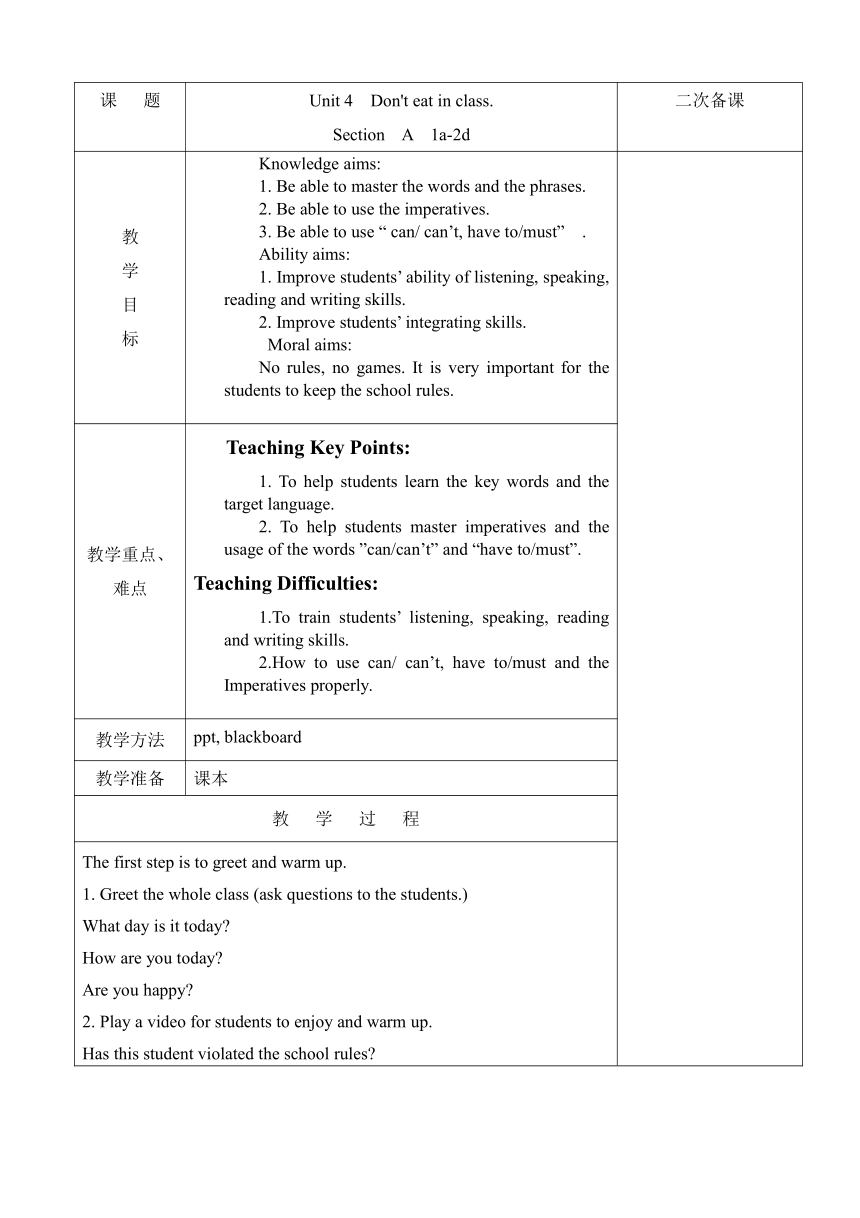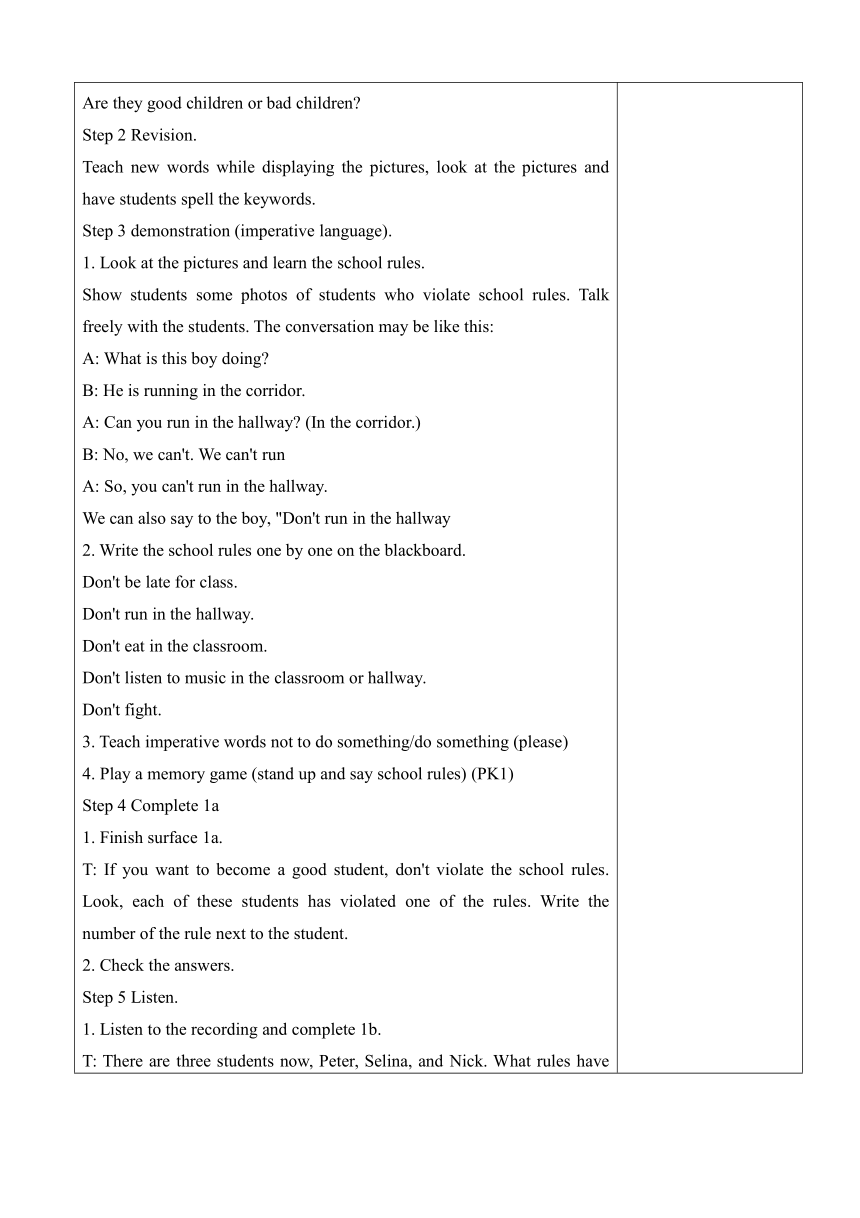Unit 4 Don't eat in class. Section A 1a-2d 表格式教案
文档属性
| 名称 | Unit 4 Don't eat in class. Section A 1a-2d 表格式教案 |  | |
| 格式 | doc | ||
| 文件大小 | 35.5KB | ||
| 资源类型 | 教案 | ||
| 版本资源 | 人教新目标(Go for it)版 | ||
| 科目 | 英语 | ||
| 更新时间 | 2023-05-10 22:02:46 | ||
图片预览


文档简介
课 题 Unit 4 Don't eat in class.Section A 1a-2d 二次备课
教 学 目标 Knowledge aims:1. Be able to master the words and the phrases.2. Be able to use the imperatives. 3. Be able to use “ can/ can’t, have to/must” .Ability aims:1. Improve students’ ability of listening, speaking, reading and writing skills. 2. Improve students’ integrating skills. Moral aims:No rules, no games. It is very important for the students to keep the school rules.
教学重点、难点 Teaching Key Points:1. To help students learn the key words and the target language. 2. To help students master imperatives and the usage of the words ”can/can’t” and “have to/must”. Teaching Difficulties: 1.To train students’ listening, speaking, reading and writing skills.2.How to use can/ can’t, have to/must and the Imperatives properly.
教学方法 ppt, blackboard
教学准备 课本
教 学 过 程
The first step is to greet and warm up.1. Greet the whole class (ask questions to the students.)What day is it today How are you today Are you happy 2. Play a video for students to enjoy and warm up.Has this student violated the school rules Are they good children or bad children Step 2 Revision.Teach new words while displaying the pictures, look at the pictures and have students spell the keywords.Step 3 demonstration (imperative language).1. Look at the pictures and learn the school rules.Show students some photos of students who violate school rules. Talk freely with the students. The conversation may be like this:A: What is this boy doing B: He is running in the corridor.A: Can you run in the hallway (In the corridor.)B: No, we can't. We can't runA: So, you can't run in the hallway.We can also say to the boy, "Don't run in the hallway2. Write the school rules one by one on the blackboard.Don't be late for class.Don't run in the hallway.Don't eat in the classroom.Don't listen to music in the classroom or hallway.Don't fight.3. Teach imperative words not to do something/do something (please)4. Play a memory game (stand up and say school rules) (PK1)Step 4 Complete 1a1. Finish surface 1a.T: If you want to become a good student, don't violate the school rules. Look, each of these students has violated one of the rules. Write the number of the rule next to the student.2. Check the answers.Step 5 Listen.1. Listen to the recording and complete 1b.T: There are three students now, Peter, Selina, and Nick. What rules have these students violated Please listen to the recording and write the numbers after the name.Peter__________ Selina _________ Nick__________2. Listen to the recording and repeat.Step 6 Action and Dialogue (PK2).T: Now, please make up a dialogue. You can work in groups of three or two. Suppose one of you is a teacher, while the others are violating the rules.model:A: Hi, Peter. What are you doing B: Sorry, madam/sir. Smith.. Students should use gesturesA: Can you eat in the classroom B: No, we can't. We cannotA: Don't eat in the classroom.B: Sorry, I don't know.Have students practice in pairs. Try to perform in front of the whole class.Step 7 Group WorkDiscuss in groups of six or four and set rules for our classroom. They should write down the classroom rules on a piece of paper and report like thisReport: Our class has many rules.We can..., but we cannot... we must... we mustCheck the answer. (Tell them to follow the rules.)Step 8 Summary - What did you learn in this lesson 9. Homework
教 学 反 思
教 学 目标 Knowledge aims:1. Be able to master the words and the phrases.2. Be able to use the imperatives. 3. Be able to use “ can/ can’t, have to/must” .Ability aims:1. Improve students’ ability of listening, speaking, reading and writing skills. 2. Improve students’ integrating skills. Moral aims:No rules, no games. It is very important for the students to keep the school rules.
教学重点、难点 Teaching Key Points:1. To help students learn the key words and the target language. 2. To help students master imperatives and the usage of the words ”can/can’t” and “have to/must”. Teaching Difficulties: 1.To train students’ listening, speaking, reading and writing skills.2.How to use can/ can’t, have to/must and the Imperatives properly.
教学方法 ppt, blackboard
教学准备 课本
教 学 过 程
The first step is to greet and warm up.1. Greet the whole class (ask questions to the students.)What day is it today How are you today Are you happy 2. Play a video for students to enjoy and warm up.Has this student violated the school rules Are they good children or bad children Step 2 Revision.Teach new words while displaying the pictures, look at the pictures and have students spell the keywords.Step 3 demonstration (imperative language).1. Look at the pictures and learn the school rules.Show students some photos of students who violate school rules. Talk freely with the students. The conversation may be like this:A: What is this boy doing B: He is running in the corridor.A: Can you run in the hallway (In the corridor.)B: No, we can't. We can't runA: So, you can't run in the hallway.We can also say to the boy, "Don't run in the hallway2. Write the school rules one by one on the blackboard.Don't be late for class.Don't run in the hallway.Don't eat in the classroom.Don't listen to music in the classroom or hallway.Don't fight.3. Teach imperative words not to do something/do something (please)4. Play a memory game (stand up and say school rules) (PK1)Step 4 Complete 1a1. Finish surface 1a.T: If you want to become a good student, don't violate the school rules. Look, each of these students has violated one of the rules. Write the number of the rule next to the student.2. Check the answers.Step 5 Listen.1. Listen to the recording and complete 1b.T: There are three students now, Peter, Selina, and Nick. What rules have these students violated Please listen to the recording and write the numbers after the name.Peter__________ Selina _________ Nick__________2. Listen to the recording and repeat.Step 6 Action and Dialogue (PK2).T: Now, please make up a dialogue. You can work in groups of three or two. Suppose one of you is a teacher, while the others are violating the rules.model:A: Hi, Peter. What are you doing B: Sorry, madam/sir. Smith.. Students should use gesturesA: Can you eat in the classroom B: No, we can't. We cannotA: Don't eat in the classroom.B: Sorry, I don't know.Have students practice in pairs. Try to perform in front of the whole class.Step 7 Group WorkDiscuss in groups of six or four and set rules for our classroom. They should write down the classroom rules on a piece of paper and report like thisReport: Our class has many rules.We can..., but we cannot... we must... we mustCheck the answer. (Tell them to follow the rules.)Step 8 Summary - What did you learn in this lesson 9. Homework
教 学 反 思
同课章节目录
- Unit 1 Can you play the guitar?
- Section A
- Section B
- Unit 2 What time do you go to school?
- Section A
- Section B
- Unit 3 How do you get to school?
- Section A
- Section B
- Unit 4 Don't eat in class.
- Section A
- Section B
- Unit 5 Why do you like pandas?
- Section A
- Section B
- Unit 6 I'm watching TV.
- Section A
- Section B
- Review of Units 1-6
- Unit 7 It's raining!
- Section A
- Section B
- Unit 8 Is there a post office near here?
- Section A
- Section B
- Unit 9 What does he look like?
- Section A
- Section B
- Unit 10 I'd like some noodles.
- Section A
- Section B
- Unit 11 How was your school trip?
- Section A
- Section B
- Unit 12 What did you do last weekend?
- Section A
- Section B
